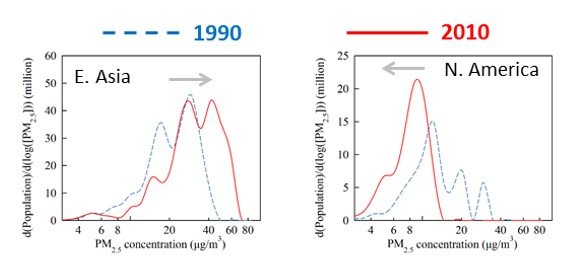Research Highlights Archive
EPA scientists have primary responsibility for the continual development of CMAQ and its related models. There are currently a number of research projects underway that focus on a range of topics, from exploration of atmospheric science fundamentals to incorporation and evaluation of recent scientific breakthroughs into research versions of the CMAQ model. Eventually, this new knowledge will serve the public by being incorporated in future publicly available CMAQ releases. The research and development team welcome comments and questions about these topics and would be happy to discuss the potential for collaborations.
Research Highlights Archive: Table of Contents
- Modeling long-term trends in nitrogen and sulfur deposition across the United States
- A Case Study Evaluation of Fog Simulation Using Two Land-Surface Models.
- Impacts of Different Characterizations of Large-Scale Background on Simulated Regional-Scale Ozone
- Impacts of particulate matter on boundary layer mixing
- Improving vegetation processes for WRF/CMAQ using MODIS vegetation (LAI and FPAR) product and a coupled photosynthesis and stomatal conductance approach
- Air-land-water integrated assessments using coupled FEST-C EPIC, WRF/CMAQ, and SWAT modeling systems
- Understanding pathways to organic aerosol
- Improving representation of sources and sinks of atmospheric particles
- Novel atmospheric chemistry pathways
- Heterogeneous chemistry on the surface of dust
Modeling long-term trends in nitrogen and sulfur deposition across the United States
Researcher: Rohit Mather
Posted: September 2018
Citation: Zhang, Y., Mathur, R., Bash, J. O., Hogrefe, C., Xing, J., and Roselle, S. J.: Long-term trends in total inorganic nitrogen and sulfur deposition in the US from 1990 to 2010, Atmos. Chem. Phys., 18, 9091-9106, https://doi.org/10.5194/acp-18-9091-2018 , 2018.
Summary: The ultimate-fate of atmospheric emissions of NOx, NH3 and SO2 and their derived products is removal by wet scavenging and dry deposition at the surface. Accurate quantification of these atmospheric sinks of airborne nitrogen and sulfur species is important not only from an atmospheric budget perspective, but also because of potential ecological effects arising from their deposition to terrestrial and aquatic ecosystems. Excess deposition of nitrogen and sulfur is detrimental to ecosystems, since it leads to decreased biological diversity, increased terrestrial and aquatic eutrophication and acidification. Accurate quantification of changes in atmospheric deposition amounts is critical for maintaining ecosystem health.
In this study, we use model simulations spanning a 21-year period from 1990-2010 to investigate the spatial distribution and temporal trends in the total inorganic nitrogen and total sulfur deposition across the U.S., including changes in chemical composition of the deposition as well as the relative importance of the wet and dry deposition components. Analysis indicate that atmospheric deposition amounts of both total inorganic nitrogen and sulfur have decreased significantly across the U.S. in response to reductions in emissions of NOx and SO2. Total inorganic nitrogen deposition decreased significantly over the Eastern Temperate Forests, Northern Forests, Mediterranean California and Marine West Coast Forest, resulting from decrease in oxidized nitrogen deposition driven by reductions in NOx emissions during this period. Nationwide, dry deposition accounted for 58-65% inorganic nitrogen deposition amount. Oxidized nitrogen dominated the total inorganic nitrogen deposition in the U.S. during the first decade but a shift occurred in 2003 when deposition of reduced nitrogen became dominant. The study highlights the growing importance of NHX deposition as emissions of NOX and SO2 have been reduced substantially over the years.
A Case Study Evaluation of Fog Simulation Using Two Land-Surface Models
Researcher: Brian Eder
Posted: August 2018
Citation: Brian Eder, Robert Gilliam, Patrick Campbell, Melissa Wrzesien , Donna Schwede and Tanya Spero, presented at the Joint WRF and MPAS Users' Workshop, Boulder, Colorado, June 11th – 15th, 2018.
Summary: Despite its importance to ecosystem health (related to pollutant and nutrient deposition), the numerical simulation of fog lags the simulation of other meteorological phenomena due, in large part, to its complexity and limitations of model resolution.
This evaluation provides a case study of fog formation/simulation in the Nooksack Valley Region centered in Washington State during an extensive fog episode in January of 2014. Numerous simulations of WRFV3.9 (4 km) were conducted using two land-surface models: PX-LSM and Noah-LSM and a variety of physics parameterizations. Two such configurations designed to provide commensurability were examined in this study focusing on a 72-hour period 00UTC 19 January – 23UTC 21 January.
A snapshot in time (19UTC 19 January) is shown below comparing a GOES (West) 1 km visible satellite image with the total liquid water content (g/kg) of the lowest 8 model layers for the PX-LSM (middle) and the Noah-LSM (right). Colorization starts at a threshold of ≥ 0.015 g/kg which corresponds to visibilities less than 1000 m, the threshold for fog as defined by the World Meteorological Society. Both LSMs simulated advection fog well (seen over the Pacific Ocean), but tend to under simulate radiation fog over the Nooksack Valley in the eastern part of the State. This underestimation, which was more prevalent with the Noah-LSM, is being investigated.
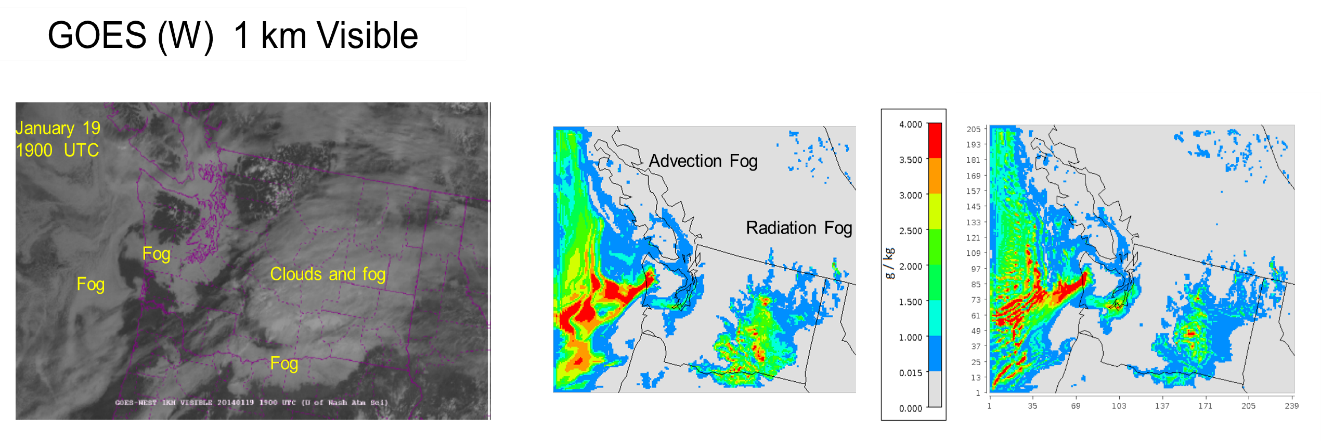
Regional and Seasonal Lightning NOx and Implications to Ground-Level Air Pollution
Researcher: Daiwen Kang
Posted: July 2018
Citation: Daiwen Kang, Rohit Mathur, Limei Ran, Gorge Pouliot, David Wong, Kristen Foley, Wyat Appel, and Shawn Roselle, presented at 36th ITM on Air Pollution Modeling and its Application, Ottawa, Canada, May 14th – 18th, 2018
Summary: As one of the largest sources of natural NOX, it is estimated that lightning-induced NOX (LNOX) contributes 10-15% of the total global NOX emissions budget. Lightning activity exhibits strong spatial and temporal variations, and consequently so does the tropospheric distribution of NOX from lightning flashes. To accurately assess the impact of LNOX on air quality, the LNOX contributions to the total NOX emissions needs to be quantified in space and time, which entails robust LNOX production and distribution schemes in air quality models. In the current version (v5.2) of the Community Multiscale Air Quality (CMAQ) model, for retrospective model simulations, we have implemented a LNOX production scheme based on hourly gridded lightning flashes from the National Lightning Detection Network (NLDN) to estimate gridded hourly total LNOX across the contiguous US. After the column total LNOX is calculated, it is distributed vertically through the model layers based on the double-peak algorithm described in Allen et al. (2012; https://doi.org/10.5194/acp-12-1737-2012).
Using the 2011 National Emissions Inventory (NEI) for anthropogenic NOx emissions and soil NO emissions estimated using CMAQ inline biogenic emission, we quantified the relative contributions of LNOx to the total NOx emissions budget in time and space for April to September 2011 over the contiguous United States. Model simulations with and without LNOx were performed to assess the impact of LNOx on ground-level air quality by region and month. The major findings from this research are:
- The contribution of LNOX emissions to the total NOX emissions ranges from 10% (September) to 22% (July) over the contiguous US.
- Averaged over the six-month period (April - September), Southeast (SE, see the map in Figure 1) has the largest LNOX ratios (20%) followed by Rocky Mountain (RM) area (16%).
- During July and August, the largest LNOX ratios are observed for the RM region (30% and 28%, respectively).
- The CMAQ simulation for summer 2011 shows that the addition of LNOx emissions reduces the daily CMAQ low bias for daily maximum 8-hr O3 by as much as 5 ppbv in the RM region.
Impacts of Different Characterizations of Large-Scale Background on Simulated Regional-Scale Ozone
Researcher: Christian Hogrefe
Posted: June 2018
Citation: Hogrefe, C., P. Liu, G. Pouliot, R. Mathur, S. Roselle, J. Flemming, M. Lin, AND R. Park. Impacts of different characterizations of large-scale background on simulated regional-scale ozone over the continental United States. Atmospheric Chemistry and Physics. Copernicus Publications, Katlenburg-Lindau, Germany, 18:3839-3864, (2018). https://doi.org/10.5194/acp-18-3839-2018
Summary: As the ozone National Ambient Air Quality Standard (NAAQS) has tightened, non-attainment areas continue to exist in a number of U.S. regions. To design efficient and effective NAAQS attainment strategies, it is important to accurately quantify the contributions of local vs. background sources (such as trans-Pacific transport of air pollution) to non-attainment. Doing so requires evaluating and advancing our modeling techniques for representing ozone fluctuations on regional-to-hemispheric scales which in turn necessitates a detailed understanding of the relevant processes (vertical mixing in source and receptor regions, multi-day transport and chemistry in the free troposphere, and stratosphere/troposphere exchange processes) and how they are represented in current-generation global and regional-scale modeling tools.
This recent study analyzed CMAQ-modeled ozone burdens over the U.S. both near the surface and aloft, estimated the contributions of different physical and chemical processes to these burdens, and calculated the sensitivity of the simulated regional-scale ozone burden to large-scale background ozone as specified by lateral boundary conditions derived from different hemispheric or global scale models using a consistent set of anthropogenic emission inputs. The analysis of these regional-scale CMAQ simulations highlighted that differences in ozone boundary conditions resulted in differences of CMAQ-simulated ozone column mass for different vertical layer ranges across the entire modeling domain. In particular, the results strongly suggest that differences in the mid-tropospheric ozone mixing ratios simulated by the large-scale models were the main driver of ozone differences between the corresponding regional-scale CMAQ simulations.
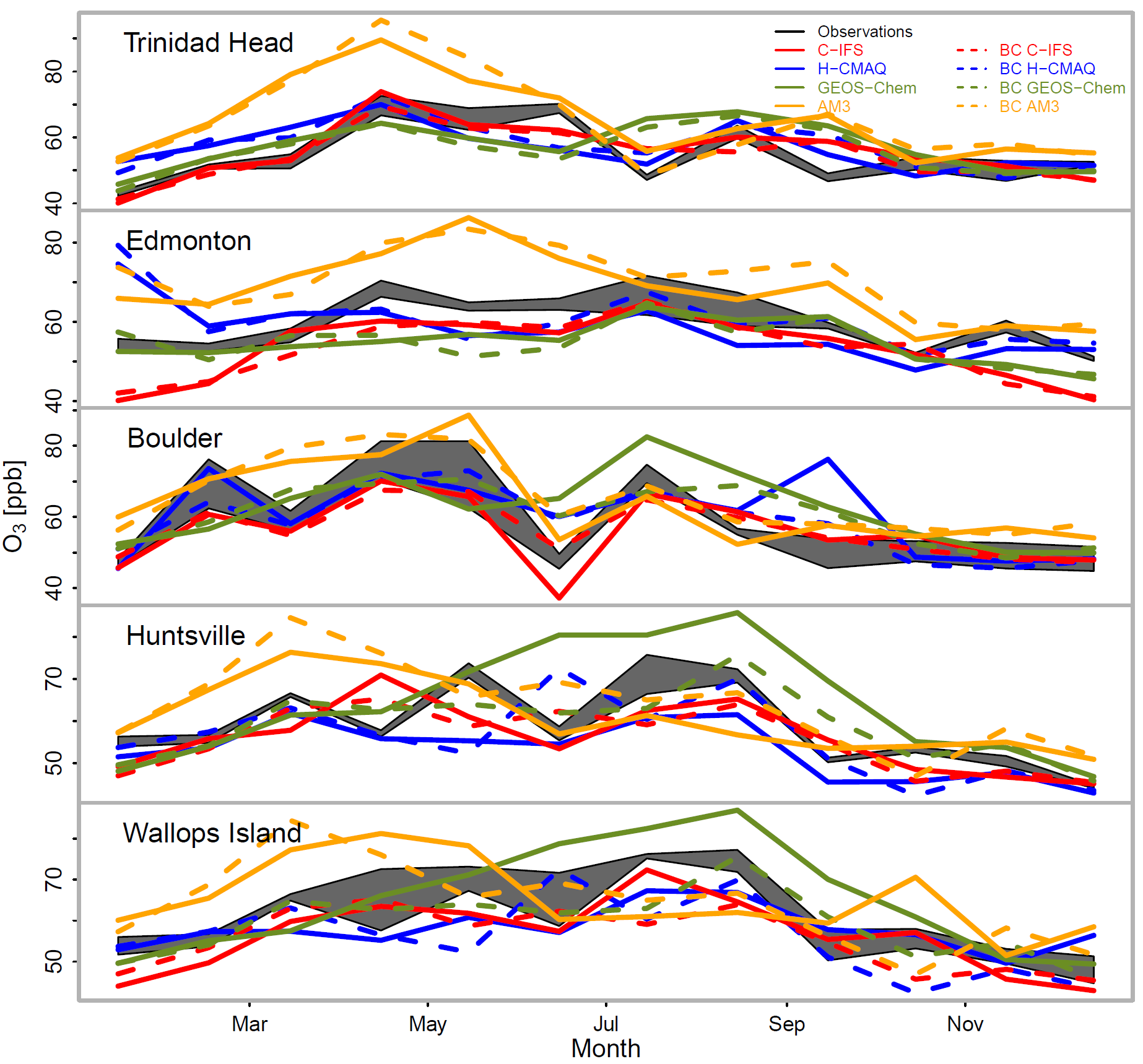
Vertical mixing, including mixing by convective clouds, couple the fluctuations in free tropospheric ozone to ozone in lower layers. Analysis of ozone mixing ratios at the surface confirmed that the characterization of ozone outside the regional-scale modeling domain can have a profound impact on CMAQ-simulated ground-level ozone and can affect the comparison of these simulations with available observations.
The study was published as part of a special issue on “Global and regional assessment of intercontinental transport of air pollution: results from HTAP, AQMEII and MICS” in the journal Atmospheric Chemistry and Physics.
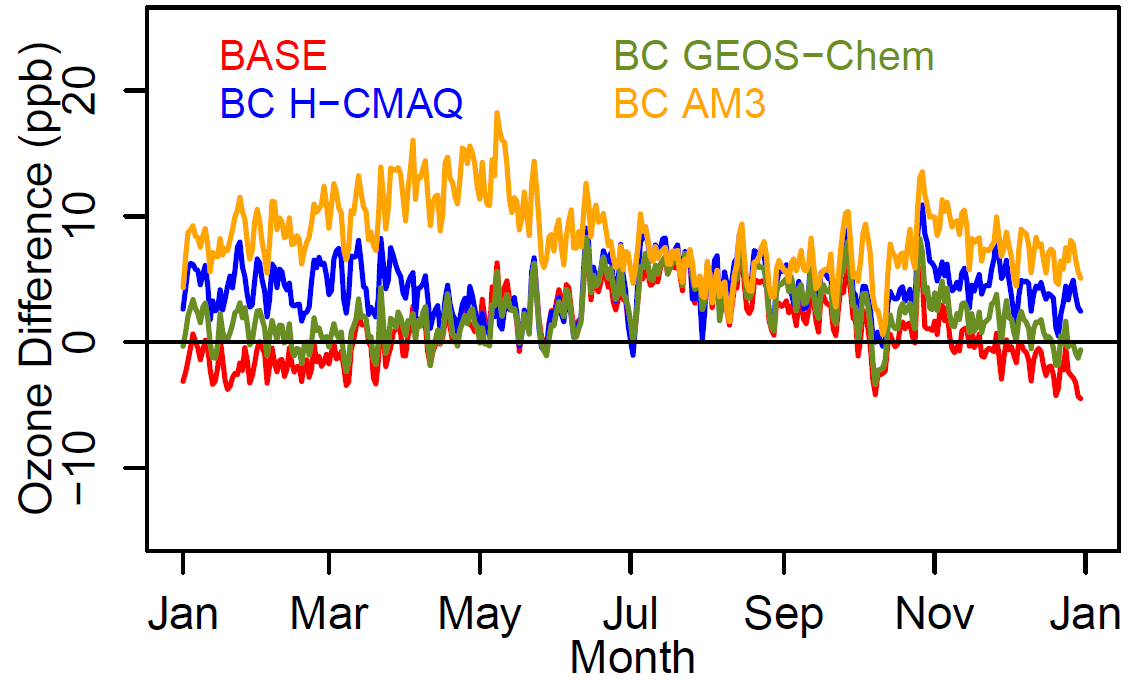
Impacts of Particulate Matter on Boundary Layer Mixing
Researcher: Rohit Mathur
Posted: June 2017
Citations: Wang, J., Xing, J., Mathur, R., Pleim, J.E., Wang. S., Hogrefe, C., Gan, C.-M., Wong, D.C., and Hao, J. (2016) Historical Trends in PM2.5-Related Premature Mortality during 1990-2010 across the Northern Hemisphere. Environmental Health Perspectives. doi: 10.1289/EHP298.
Xing, J., Wang, J., Mathur, R., Pleim, J., Wang, S., Hogrefe. C., Gan, C.-M., Wong, D.C., and Hao, J. (2016). Unexpected Benefits of Reducing Aerosol Cooling Effects. Environ. Sci. Technol, 50(14), 7527–7534. doi: 10.1021/acs.est.6b00767.
Summary: Two journal articles on comprehensive modeling of 1990-2010 trends in air pollution exposure across the Northern Hemisphere demonstrate the benefits of EPA's fine particulate matter (PM2.5) control measures, including some that were unexpected. Modeling results in Wang et al. (2016) indicate that while PM2.5-related mortalities in East Asia and South Asia increased 21 percent and 85 percent, respectively, they decreased in Europe and North America substantially by 67 percent and 58 percent respectively. A companion article, Xing et al. (2016), shows that while fine particles contributed to cooling effects, partially offsetting greenhouse gas warming, because of reduced atmospheric mixing resulting from the cooling, air pollutants become more concentrated locally, especially in highly polluted and populated regions. Therefore, control measures aimed at reducing PM2.5 -related mortalities, result in unexpected additional benefits, making the controls even more effective than originally projected.
Improving Vegetation Processes for WRF/CMAQ Using MODIS Vegetation (LAI and FPAR) Product and a Coupled Photosynthesis and Stomatal Conductance Approach
Researcher: Limei Ran
Posted: June 2017
Citations: The following links exit the site Ran, L., Gilliam, R., Binkowski, F.S., Xiu, A., Pleim, J., & Band, L. (2015). Sensitivity of the WRF/CMAQ modeling system to MODIS LAI, FPAR, and albedo. J. Geophys. Res. Atmos., 120(16), 8491-8511. https://doi.org/10.1002/2015JD023424
Ran, L., Pleim, J., Gilliam, R., Binkowski, F.S., Hogrefe, C., & Band, L. (2016a). Improved meteorology from an updated WRF/CMAQ modeling system with MODIS vegetation and albedo. J. Geophys. Res. Atmos., 121, 2393–2415. https://doi.org/10.1002/2015JD024406
Ran, L., Pleim, J., Song, C., Band, L., Walker, J.T., & Binkowski, F.S. (2016b). A Photosynthesis-based Two-leaf Canopy Stomatal Conductance Model for Meteorology and Air Quality Modeling with WRF/CMAQ PX LSM. J. Geophys. Res. Atmos. https://doi.org/10.1002/2016JD025583.
Summary: EPA scientists have been working on improving land surface processes in the Wweather Research and Forecasting (WRF)/CMAQ modeling system with a focus on vegetation. With realistic MODIS vegetation being evaluated and ingested into the system (Ran et al., 2015; Ran et al., 2016a) and a coupled photosynthesis and stomatal conductance approach being evaluated for the system (Ran et al., 2016b), scientists are implementing the photosynthesis-based approach into the system. Meanwhile, EPA researchers are developing new land cover categories with irrigation information and plant function types which are more suitable for the photosynthesis-based approach. The CMAQ team is also developing and evaluating a simple irrigation scheme in WRF for preparing to use the new land cover categories. Ultimately, the system with improved land surface representation and vegetation processes can be used to assess the coupling effects of air quality, climate, and vegetation productivity directly with CO2 concentration which changes temporally and spatially. For example, the system will have the ability to assess the effects of air pollutants such as O3 on ecosystem productivity in addition to CO2 influence.
Air-Land-Water Integrated Assessments Using Coupled FEST-C EPIC, WRF/CMAQ, and SWAT Modeling Systems
Researchers: Ellen Cooter and Limei Ran
Posted: June 2017
EPA researchers are continuing efforts on improving and advancing an agriculture fertilization and production model (FEST-C EPIC) coupled with WRF/CMAQ and the Soil and Water Assessment Tool (SWAT) for air quality and ecosystem assessments. This coupling is required for bidirectional CMAQ simulations. Improving this coupling leads directly to improved CMAQ estimates of nitrogen (N) deposition and emissions (N removal) and particulate matter concentrations. Currently, the system is used to assess the impacts of agricultural fertilization and management practices on air quality (NH3) and climate (N2O), as well as the impacts of meteorology/climate and air quality (N deposition) on crop yield, soil erosion and water quality at regional scales. EPA scientists are improving the system on the crop and biomass production in comparison with USDA reports. As climate change is affecting agriculture, crop production under different climate and air quality, like OOzone (O3) is a colorless gas with a pungent odor. It is found in two layers of the atmosphere, the stratosphere and the troposphere. In the stratosphere, ozone provides a protective layer shielding the Earth from ultraviolet radiation's potentially harmful health effects. At ground level (the troposphere), ozone is a pollutant that affects human health and the environment, and contributes to the formation of smog. damage, scenarios can be assessed using this system to address food security, risk mitigation, and policies with a holistic approach. The CMAQ team is assessing the impacts of climate on fertilization and productions and in turn on water quality through 11-year simulations using the integrated system. The system will be expanded to the globe for the next generation air quality modeling system at the global scale. Ongoing research focuses on other predicted FEST-C EPIC variables such as temporally resolved leaf area index for natural vegetation, like mixed forest, and dust emissions associated with agricultural tillage activities.
Understanding Pathways to Organic Aerosol
Researcher: Havala Pye
Posted: June 2017
For organic compounds of high solubility or low vapor pressure, the particle phase is an intermediate in their life cycle in the atmosphere. Due to thousands of compounds being present in organic aerosol, multiple approaches have been used to represent the formation of organic aerosol. Improvements in the representation of secondary organic aerosol as well as emitted organic aerosol are still needed to improve the CMAQ team’s confidence in how organic aerosol can be expected to respond to changes in emissions.
Improving Representation of Sources and Sinks of Atmospheric Particles
Researcher: Ben Murphy
Posted: June 2017
Particles are introduced to the atmosphere via both direct emissions (primary) and transformation of low-volatility vapors (secondary). In order to understand and quantify the importance of both of these pathways, we have enhanced the representation of the particle size distribution in CMAQ to treat four modes, Nucleation, Aitken, Accumulation and Coarse. We are currently investigating the incorporation of state-of-the-art parameterizatoins for new particle formation from sulfuric acid, ammonia, amines, and organic compounds. Meanwhile, we are also investigating the effect of representing particle direct emissions with source-specific size distributions from, for example, automobiles, fires and power plants.
Studies show that partitioning of organic compounds is important for combustion sources of primary particulate matter to the atmosphere. Example combustion sources include vehicles, power generation, residential wood burning, prescribed and wild fires, construction equipment, and yard appliances among others. New parameterizations exist for modeling the volatility distribution of these compounds. However, there is a potential disconnect between the experimental conditions at which these parameterizations were developed and the conditions at which emission factors were obtained for input to the National Emissions Inventory and SPECIATE databases, which are used to inform anthropogenic emissions in models. Current efforts will determine how to adjust available speciation profiles to ensure consistency among these data sources and provide photochemical models with accurate combustion emissions.
Understanding the removal processes of atmospheric pollutants is many times just as important as understanding their sources. Thus, we are currently improving the ability CMAQ to represent both in-cloud and below-cloud scavenging of particles at local and regional scales. When employed, these improvements to the particle representation will allow CMAQ to predict particle size distributions with enhanced accuracy and lend confidence to applications that use CMAQ data to interpret human health impacts of pollution, for example.
Novel Atmospheric Chemistry Pathways
Researcher: Golam Sarwar
Posted: June 2017
Iodine and Bromine Chemistry
Iodine and bromine, emitted from seawater, can participate in atmospheric chemistry and affect air quality. Atmospheric chemistry of iodine and bromine speciesAn individual molecule or chemical compound. has been included in the CMAQv5.2 model. Studies also suggest that iodine and bromine species can participate in heterogeneous reactionsHeterogeneous reactions occur between reactants in two or more phases (e.g., solid and gas, solid and liquid) or in with participation of an interface (e.g., on the surface of a solid catalyst).. These heterogeneous reactions are being identified and incorporated into the CMAQ model. EPA scientists will perform model simulations to examine the impacts of the updated iodine and bromine chemistry on air quality.
Sulfur Chemistry
Current air quality models fail to capture elevated observed sulfate levels during winter. Recent field and chamber studies suggest new chemical pathways that can produce sulfate in the atmosphere. In this study, EPA scientists are identifying and implementing relevant chemical reactions into CMAQ.
Dimethylsulfide Chemistry
Sulfate aerosol forms from the gas- and aqueous-phase oxidation of sulfur dioxide. Dimethylsulfide (DMS), present in seawater, can be emitted into the atmosphere where it can react with atmospheric oxidants to produce sulfur dioxide, leading to sulfate formation. EPA scientists are incorporating DMS emissions and its atmospheric chemistry into the CMAQ model. The CMAQ team will perform model simulations to examine the impact of DMS chemistry on sulfate.
Heterogeneous Chemistry on the Surface of Dust
Researcher: Hosein Foroutan
Posted: June 2017
Many studies have suggested that dust particles can act as a platform for heterogeneous chemistry that can affect important species concentrations such as ozone and sulfate. Following the implementation of a new windblown dust emission model in CMAQ, the heterogeneous reactions that can occur on dust particles are being identified and incorporated into the CMAQ model. EPA scientists are performing model simulations to examine the impacts of the dust chemistry on pollutant concentrations and air quality.
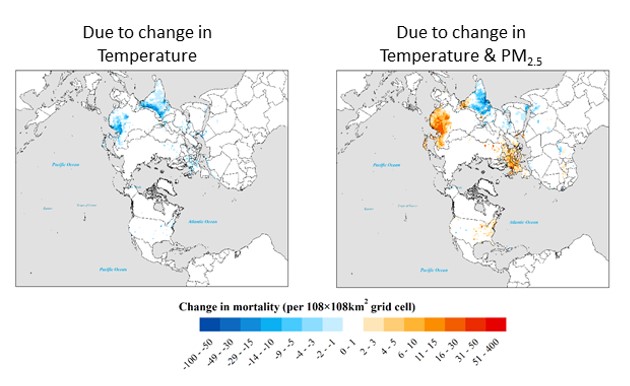
Modeling long-term trends in nitrogen and sulfur deposition across the United States
Researcher: Rohit Mather
Posted: September 2018
Citation: Zhang, Y., Mathur, R., Bash, J. O., Hogrefe, C., Xing, J., and Roselle, S. J.: Long-term trends in total inorganic nitrogen and sulfur deposition in the US from 1990 to 2010, Atmos. Chem. Phys., 18, 9091-9106, https://doi.org/10.5194/acp-18-9091-2018 , 2018.
Summary: The ultimate-fate of atmospheric emissions of NOx, NH3 and SO2 and their derived products is removal by wet scavenging and dry deposition at the surface. Accurate quantification of these atmospheric sinks of airborne nitrogen and sulfur species is important not only from an atmospheric budget perspective, but also because of potential ecological effects arising from their deposition to terrestrial and aquatic ecosystems. Excess deposition of nitrogen and sulfur is detrimental to ecosystems, since it leads to decreased biological diversity, increased terrestrial and aquatic eutrophication and acidification. Accurat

